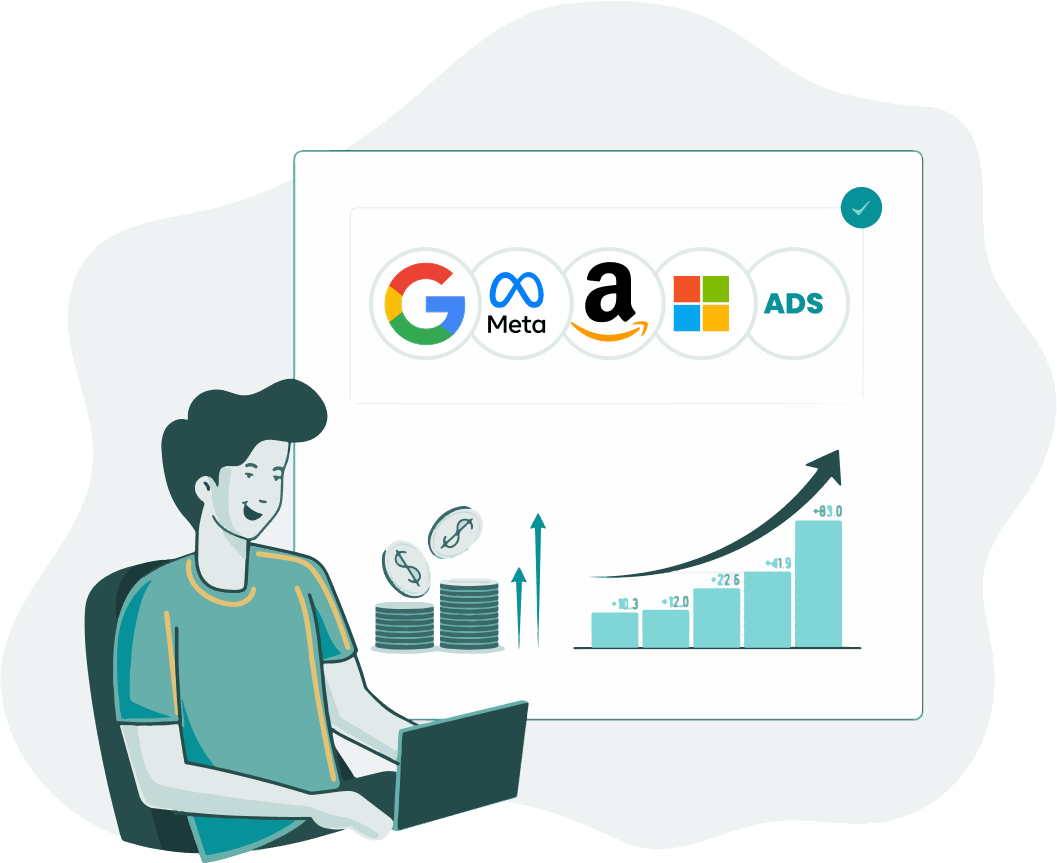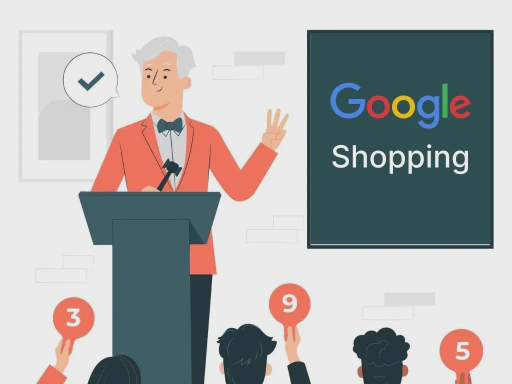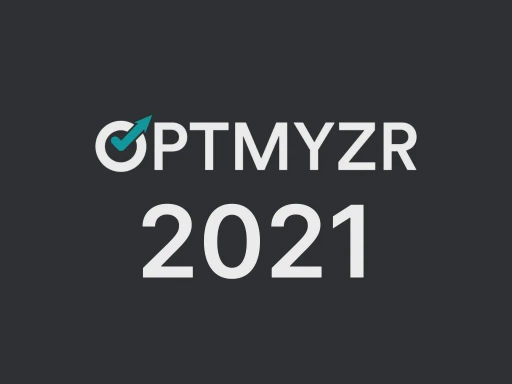If you aren’t using PPC automation tools in your Google Ads campaigns in 2023, you’re leaving money on the table.
For years, we’ve been warning PPC campaign teams about the time-killers that limit revenue growth and eat into margins. Today, we have proof that these threats are more pronounced than ever before.
Boston Consulting Group confirmed that PPC automation performs best with human input, leading to 15% better campaign performance. Brands that fail to pair machine efficiency with human oversight won’t perform as strongly as ones that do.
Smart businesses run smart campaigns.

The good news is small and big businesses alike can start using automation to their advantage today, whether it’s the capabilities within Google Ads or a robust third-party solution like Optmyzr.
This article answers all the big questions including:
- How automation has changed Google Ads management
- Examples of PPC automation tools and why they’re valuable
- Why automation is important to search engine advertising
- Which elements of PPC campaigns you should optimize first
How Google Ads Automation Has Redefined PPC Ads
Google, Microsoft, Meta/Facebook, Amazon — virtually all PPC platforms are moving towards a single goal: automation solutions and automation features to make paid ads easier.
The Shift in PPC Management
Since 2020, Google has released more and newer capabilities to their PPC automation suite, each one taking less time to go from beta to default.
Google Ads PPC Automation Capabilities (2020 – Late 2022)
- September 2020: Search terms report starts showing significantly less data
- March 2021: Responsive search ads become the default text ad format
- May 2021: Google Ads reps begin pushing automated recommendations
- June 2021: Broad Match Modified is finally deprecated
- July 2021: Target ROAS and Target CPA bidding strategies are absorbed into Maximize Conversions and Maximize Conversion Value, respectively
- September 2021: Broad Match becomes the Google Ads preferred keyword match type
- January 2022: Performance Max in introduced with limited visibility and control
- June 2022: Expanded text ad campaigns can no longer be created or edited
- Late 2022: Smart Shopping is no longer available, being replaced by Performance Max
Computers were already better than humans will ever be at math and processing large quantities of data. Now, and with access to your unique business data, they’re starting to learn what levers to pull to make PPC ad campaigns spend more efficiently and run more optimally.
Will Automated Solutions Replace PPC Experts?
Google Ads’ advanced algorithms are smart and getting smarter. The ugly truth is that Google’s AI and machine learning systems can now do a lot of the things that PPC specialists have been doing for the past decade, and more.
Fortunately, PPC managers still have a crucial role — just not the one they’re used to. The future of humans in PPC will be about data quality and amplifying that which computers are unable to simulate, such as creativity and nuanced decision-making.
Collaborating with Algorithms
While PPC software and machine learning may provide actionable data, it’s up to you to combine data and business intuition. In the end, you will make the final call — not the algorithm.
PPC Automation Layering Brings Security, Control, Visibility
It’s not easy to let go of what you’re used to controlling. Letting Google handle much of the lever-pulling is a major adjustment, but it’s the hand search engine advertisers have been dealt.
Keeping track of all that automation can be time-consuming and mentally exhausting — you’re human, and it’s impossible to keep an eye on everything all the time.
This is especially true for marketers looking over multiple PPC campaigns at once across multiple ad platforms.
With PPC automation layering, you deploy one or more automation workflows in conjunction with the automation used by ad platforms like Google.
Marketers who use automation layering typically crave one or more of these benefits of PPC automation software.
Benefits of PPC Automation Software
- Security: With multiple automation layers, a malfunction or error from ad platform automation has to get through several safeguards before it can adversely affect campaign performance. It’s like having insurance for your PPC accounts.
- Control: Automation layering for PPC restores part of the control that ad platform automation takes away from marketers. The right automation tools connect directly to APIs, allowing you to bypass or reverse certain limitations.
- Visibility: Platforms like Google often have delayed reporting, so it can be hours or days before you notice that something’s gone wrong. PPC automation layering (like alerts) can give you real-time visibility into what’s happening to your account, letting you intervene immediately
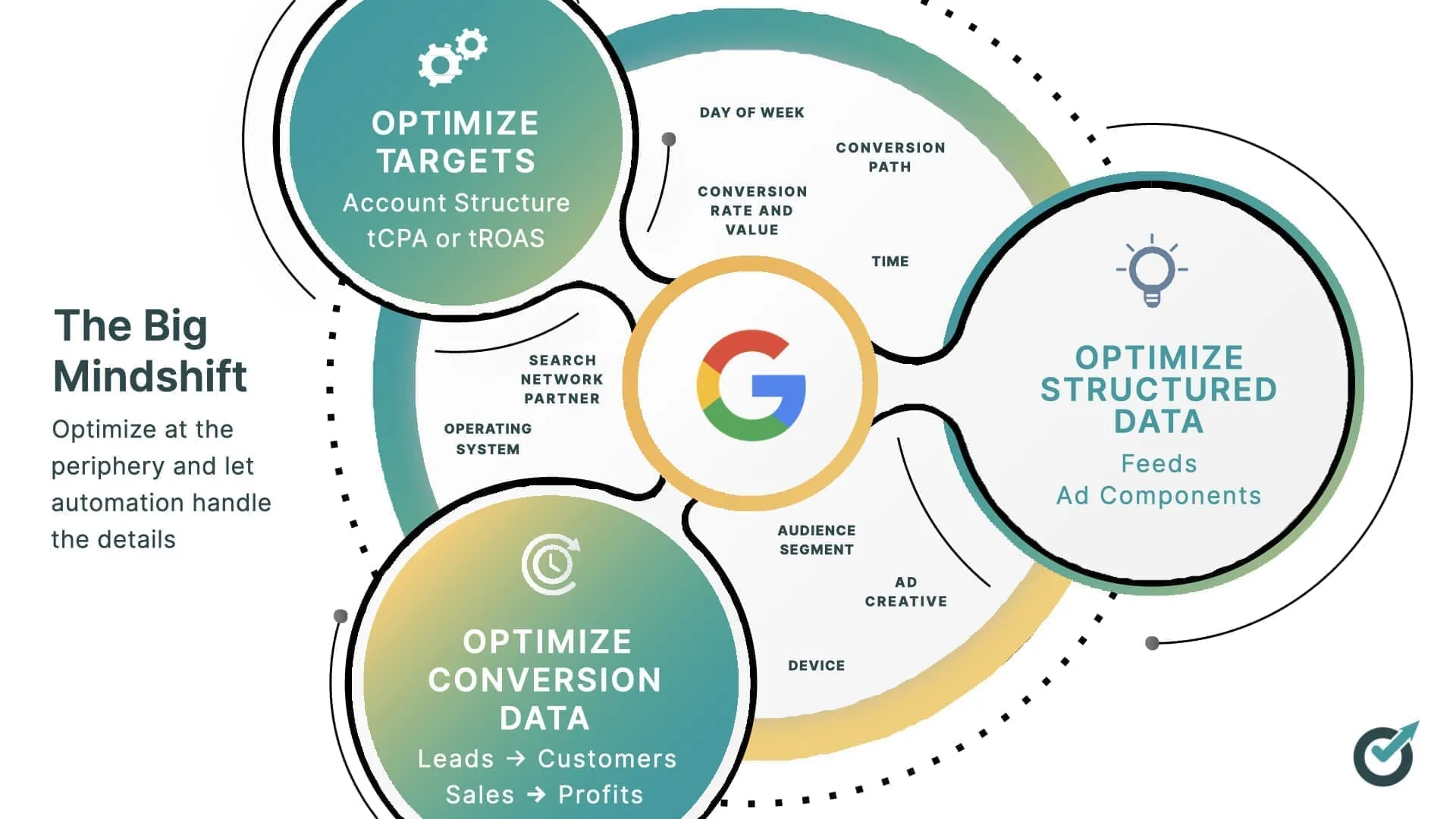
Modern PPC management is no longer about pulling levers and pushing buttons in an ad interface. Today’s marketers need to prioritize providing high-quality inputs and vetting ad platform outputs.
Automation layering makes that not only possible, but faster and more efficient.
Here are some of the optimizations we recommend PPC marketers focus on.
Optimization Recommendations for PPC Campaigns
- Account Structure: How your campaigns are organized, their objectives, and the keywords and audiences they target
- Creative Assets: Website and ad copy, creatives, and videos for a range of campaign types including responsive and dynamic search ads, discovery, display, and YouTube
- Structured Data: Product and data feeds for shopping, Performance Max, and inventory-based search and display campaigns
- Targets: Finding the sweet spot for return on ad spend (ROAS) or cost per acquisition (CPA) targets when using Smart Bidding
- Conversions Data: Feeding first-party offline and post-conversion data back into Google so that it can find more leads likely to become profit-generating customers
Automation Layering in Action: Smart Bidding Use Case
Smart Bidding is one of the more widely accepted incarnations of automation from Google Ads, but it’s far from perfect. Let’s take a look at what happens when things go wrong and how automation layering can save the day.
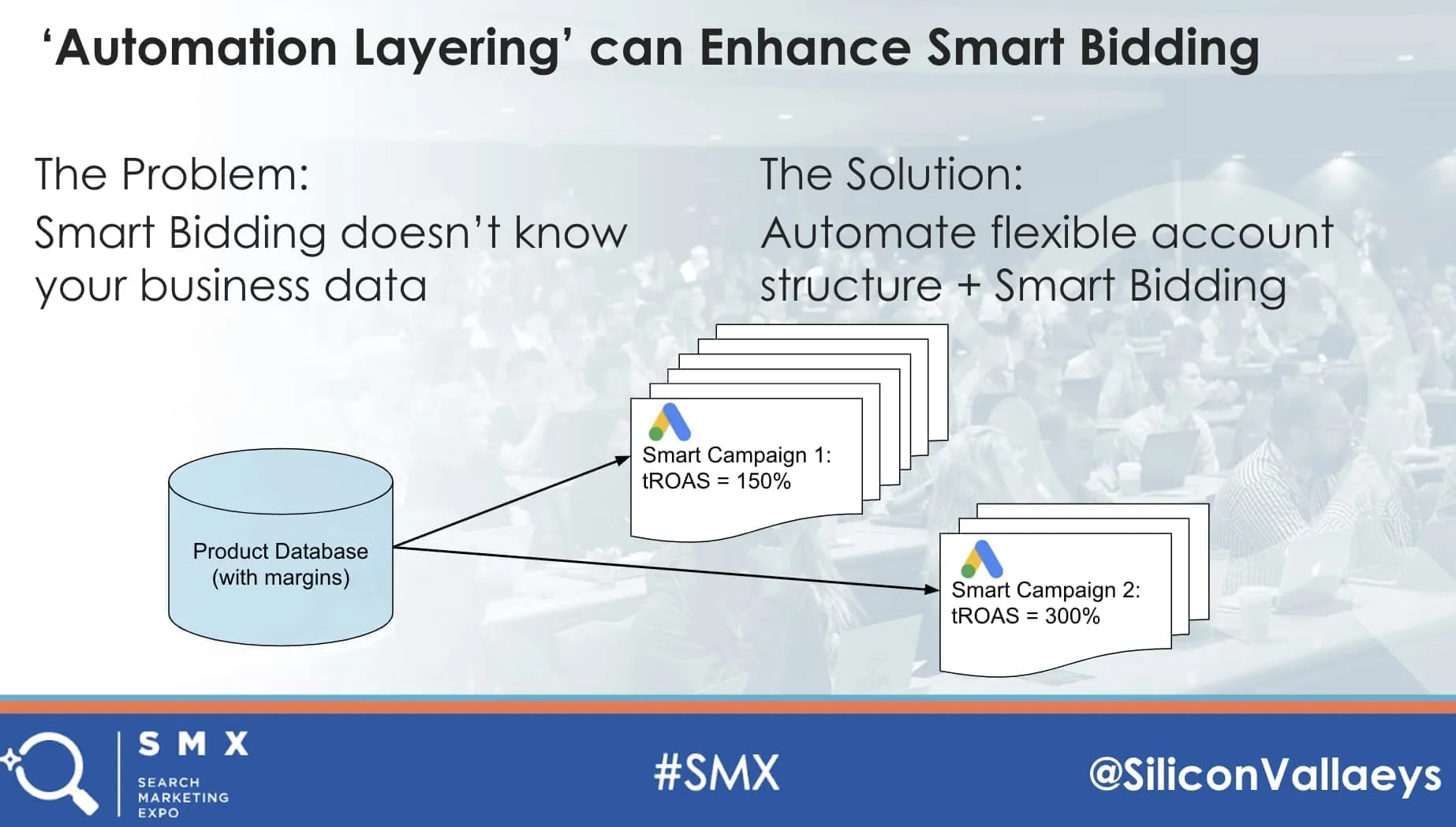
PPC marketers embrace Smart Bidding because by allowing Google to set and adjust bids in real time, they save considerable time and energy.
However, Smart Bidding can also expose campaigns to risks such as algorithmic malfunctions.
Proactively Avoid Potential Malfunctions in Automated Bidding
One potential malfunction (which has happened multiple times) is a spike in bids, typically caused by machine error when reading seasonal or historical data.
Without automation layering, it could be hours or even days before you notice that one of your accounts has been bidding 500% of its historic cost per click, exceeding the allocated budget and throwing profitability out the window.
Now imagine you’ve set up an alert that sends you a Slack notification the moment your average CPC exceeds a given threshold, within a specified amount of time.
Or perhaps you’ve created a rule-based workflow that automatically pauses any ad groups when spend exceeds a given value.
Serve Your Own Goals with PPC
Both of these are examples of automation layering — they require a third-party tool like Optmyzr — that creates layers of added security between Google’s automation and your campaigns.
More importantly, it’s automation that you configure and control, so it serves your interests rather than those of the advertising platforms you advertise on.
At the end of the day, Google is still a for-profit business that prioritizes the financial performance that comes with increased ad spend.
3 Steps to Prepare for the Impact of PPC Automation
In his presentation Beyond Click Metrics, Mike Ryan of Smarter Ecommerce draws an interesting parallel between PPC automation and the act of driving a car.
“Google’s automation is often described as a black box – I’ve even described it as a black hole. But I’d like to take the heat out of that conversation and simply unpack the automation concept a bit, inspired by research in the field of automated driving.
“In plain words, driving is the sum of monitoring and control activity at multiple levels. These range from navigation, event detection and response; to physical actions like braking. We could use this same framework to describe how campaigns are controlled as well.
“Navigation could be thought of in terms of goals and budgets; steering in terms of keywords, schedules, and modifiers; and the gas and brake pedals in terms of CPC bidding. Automation seeks to overtake those different control loops, while humans occupy different states along a spectrum of awareness and control, from in the loop to out of the loop.
“Not only are Google campaign actions being reduced, but observability and reporting have been limited as well. I see a two-fold challenge there. How can we best guide the platform toward our objectives with fewer tools at hand, and how can we differentiate from competitors using the same technology?”
Advertisers in paid search and ads need to take three important steps to avoid “merely participating in Google channels, rather than controlling them”.
1. Protect Yourself from Ad Platform Agendas
Google and other ad platforms have the same primary goals as any other enterprise: profit and shareholder value. Helping advertisers reach the right target audience and improve business performance is only a way to achieve those goals.
This makes automation layering an important tool to regain control.
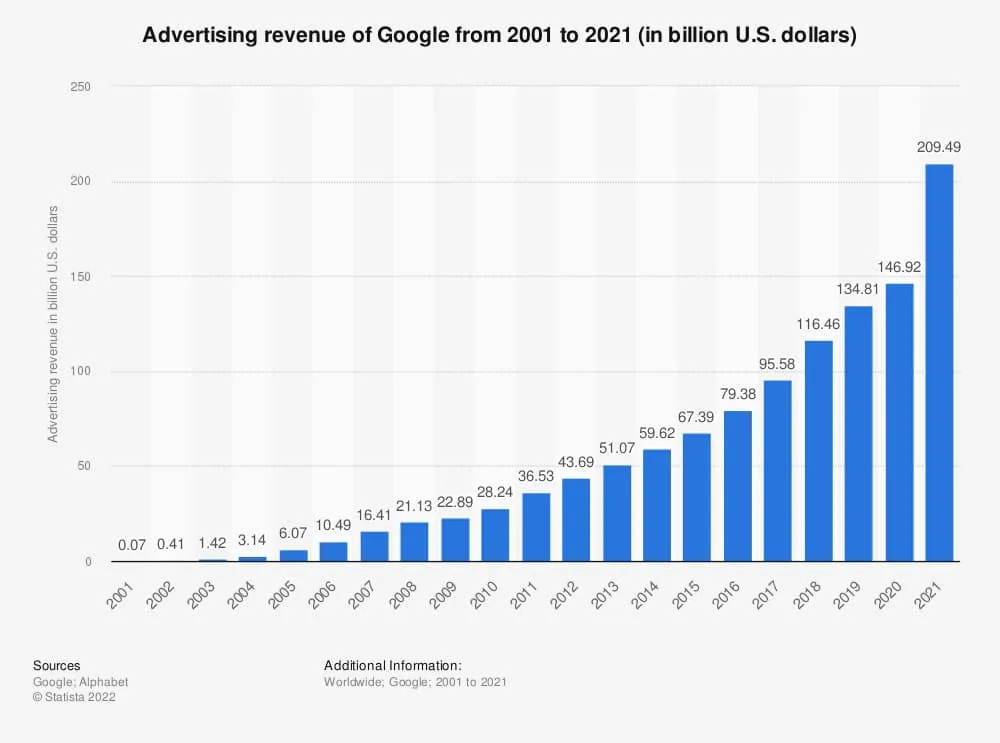
While some experts view PPC automation as disruptive, Google sees thousands of brands and businesses who don’t use Google Ads because they find it too complicated.
Automation opens up a huge market and untold millions in revenue, but it also puts Google at conflict with PPC experts who’ve mastered more hands-on ad management over the years.
Don’t Just Set It and Forget It
Automated capabilities like Smart Bidding or responsive search ads can turn disruptive when you apply a “set it and forget it” mentality.
We saw this last year when Smart Shopping CPCs went through the roof and advertisers remained unaware for hours. Rule-based automation could have notified the advertisers the moment those bid amounts spiked.
2. Insulate Yourself From Economic Unpredictability and Volatility
If global conditions since 2020 have taught us anything, it’s that every marketer should always expect the unexpected.
From unconventional windows for holiday shopping to supply chain issues, the past few years have offered plenty of real-world situations that sent PPC strategies haywire.
Who knows what will disrupt your bid management this year?
Your reminder that shipping container costs are STILL sky-high even if talking about the supply chain is old news. https://t.co/d47quy7uwP pic.twitter.com/9S0350lDE3
— Kirk Williams (@PPCKirk) February 8, 2022
Have Safeguards Ready to Go
External events will always dramatically shift consumer behavior, so you should have safeguards ready to go. In PPC campaigns, automation layering can minimize losses and limit added expenditure.
When your targeted audience shifts, find ways to keep data clean and minimize movement to potential negative keywords.
While alerts, scripts, and automated workflows and rules can’t stop a health crisis from invalidating recent data and trends, they can help you limit any damage until the system corrects itself.
3. Make the Right Choices for Your Business with PPC Automation Tools
From paper-thin margins to creating a healthy runway, there are a number of motivating factors behind why businesses chase greater success with fewer resources. Of course, success means different things to different businesses.
For an agency, it could mean doubling your managed ad spend or improving the quality of your service without hiring additional marketers.
Third party automation tools can amplify the control of your campaign creation, planning, and monitoring.

Stay in Control of Your Insights
Giving your team a third-party automation solution like Optmyzr — rich enough in insights and flexible enough to let you apply them as you see fit — is a great way to stay in control of what Mike calls a “closed-loop system where you have only input and output”.
“Measure the right things, measure them better, and offer smart inputs,” Mike adds. “This could mean offering Google first-party target audience data, optimizing on profit rather than revenue, bringing in more detailed product data — or any number of efforts to educate Google’s automation.
“In a supply chain crisis, for example, it could be more important than ever that your ecommerce campaigns consider availability, sell-through rate, and on-order status.”
Changing the Way We Think About PPC Automation
Feeling like Google is replacing you is a tough pill to swallow, but the truth is that human PPC experts offer so much more than the ability to push the right buttons.
Your real value is your ability to contextualize and think creatively, so look at Google’s automation features as a complement rather than as a competitor.
- Set up monitoring systems to keep an eye on performance
- Go hands-on to test for optimal solutions for messaging, structure, etc.
- Sharpen Google’s decision-making by sharing post-conversion data
While Google’s automation tools feels like a blanket solution for PPC advertisers of no particular type, we know that one size never fits all.
Shape Google’s Tools to Your Accounts and Business
Automation layering is how you shape what Google does to suit your brands and accounts.
“This is a digital marketing journey, and even a total business journey,” Mike adds. “You’ll need to align with finance teams, business intelligence teams, and use test-and-learn practices along the way. Those with the best hypotheses and the fastest speed of learning will out-compete.”
Frequently Asked Questions (FAQ)
What is PPC automation?
PPC automation combines AI, machine learning, and logic-based automation to streamline the management of pay-per-click (PPC) advertising campaigns.
Digital marketing agencies, advertisers, direct-to-consumer ecommerce brands, and online retailers use PPC automation tools to focus on marketing activities that impact business growth.
What are the benefits of PPC automation tools?
PPC automation has multiple benefits and outcomes including:
- Allocating ad budgets or ad spend efficiently to high-performing assets
- Saving time, especially by automating repetitive, PPC tasks
- Monitoring performance even while completing other tasks
- Developing PPC reports without having to manually collect and organize data
- Analyzing large amounts of data with zero risk of error
- Completing anomaly investigations much faster than doing them manually
What are some examples of PPC automation tools?
PPC automation takes many shapes and forms, but the three most common ones are scripts, alerts, and automated rules.
PPC Scripts
Google Ads scripts are blocks of code that tell Google Ads to monitor for something and take action when it’s found. While effective, scripts are a roadblock to anyone unfamiliar with Javascript, making them inaccessible and time-consuming.
Optmyzr offers what we call Enhanced Scripts — these can be set up through our UI and require zero coding expertise.
They can be customized for a variety of purposes, including budget management and checking for broken landing pages.
PPC Alerts
Alerts are notifications that tell you something in your PPC account requires attention, such as anomalies or deviations in performance.
They’re often the first line of defense for PPC marketers who have better things to do than stare at an interface all day.
When ad spend is spiking out of control, your team will know at the very moment - not after the money is spent.
Optmyzr customers can create alerts for budgets or any trackable KPI at the account, campaign, label, bid strategy, or campaign type level.
Define your date range and values, and choose to be notified via email, Slack, Microsoft Teams, or any other software (via Zapier) so that you know the moment something is wrong on one of the ad platforms.
PPC marketing does not need to be stressful and worrisome. PPC tools can allow you to run multiple campaigns with ease and less anxiety.
Automated PPC Rules
Automated rules use simple “if x, then y” logic to take specific action when certain conditions are met.
Advertisers determine what those conditions and actions are, but what you can control depends on where you build those rules.
You have more options and greater control using an API-connected PPC automation tool solution like Optmyzr.
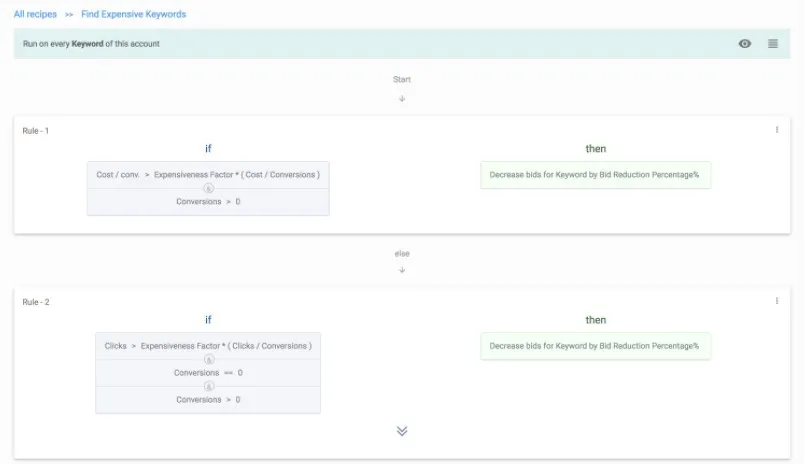
That’s what makes the Rule Engine one of our most popular automation tools. It saves advertisers a tremendous amount of time, money, and hassle by automating rule-based workflows, such as applying bulk changes or pausing expensive keywords.
In fact,the Rule Engine is so versatile that you can automate any routine tasks or process that you can write down.
This article was originally published on February 21, 2022 and was last updated on January 16, 2023.






